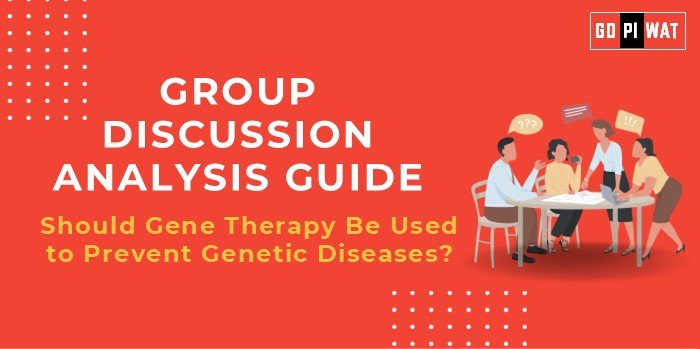📋 Group Discussion (GD) Analysis Guide: Should Gene Therapy Be Used to Prevent Genetic Diseases?
🌐 Introduction to Gene Therapy
Opening Context: Gene therapy represents a revolutionary frontier in medical science, offering the potential to address and prevent genetic diseases that were previously deemed untreatable. It brings hope but raises ethical, economic, and scientific debates.
Topic Background: Gene therapy involves modifying genes within an individual’s cells to treat or prevent disease. The first gene therapy was approved in the U.S. in 2017, sparking discussions about its broad applications and limitations.
📊 Quick Facts and Key Statistics
- 🌍 Global Market Size: $11.9 billion in 2023, projected to reach $45.4 billion by 2030, showcasing rapid investment in the technology.
- 🧬 Diseases Treated: Over 100 clinical trials for genetic disorders like cystic fibrosis and muscular dystrophy, reflecting its growing therapeutic scope.
- 💰 Cost: One-time therapies like Zolgensma cost $2.1 million, highlighting affordability concerns.
- ✅ Approval Milestones: 15+ therapies approved globally, marking steady regulatory progress.
👥 Stakeholders and Their Roles
- 🏛️ Governments: Regulate therapies and fund research.
- 🏢 Biotech Companies: Develop and commercialize therapies.
- 🩺 Healthcare Providers: Deliver treatments and counsel patients.
- 👥 Patients and Advocates: Push for affordable and equitable access.
🏆 Achievements and Challenges
Achievements:
- ✨ Regulatory Progress: FDA and EMA approval of groundbreaking therapies like Zynteglo.
- 💡 Rare Disease Cures: Life-saving treatments for conditions like spinal muscular atrophy.
- 🛡️ Cancer Treatments: Use of CAR-T cell therapies.
- 🔬 Technological Advancements: Significant progress in CRISPR-based gene editing.
Challenges:
- 💰 High Treatment Costs: Limiting accessibility for most patients.
- ⚖️ Ethical Dilemmas: Concerns surrounding germline modifications.
- 🔍 Safety Issues: Immune responses and off-target effects remain significant risks.
- 📋 Regulatory Hurdles: Delays in approvals affecting global adoption.
🌏 Global Comparisons:
- 🇨🇳 Successes: China leads in CRISPR research.
- 🇺🇸 Clinical Trials: The U.S. spearheads approvals for innovative therapies.
- 🌍 Challenges: Developing nations face barriers due to cost and infrastructure gaps.
📖 Case Studies:
India’s gene therapy for beta-thalassemia at CMC Vellore demonstrates promising affordability models.
📚 Structured Arguments for Discussion
- ✅ Supporting Stance: “Gene therapy has proven to be life-saving for rare genetic diseases, representing the future of personalized medicine.”
- ❌ Opposing Stance: “The exorbitant costs and potential long-term risks make gene therapy inaccessible and ethically questionable.”
- ⚖️ Balanced Perspective: “Gene therapy offers transformative potential but requires careful ethical, financial, and regulatory considerations.”
🎯 Effective Discussion Approaches
- 💡 Opening Approaches:
- Statistical Highlight: “The gene therapy market, worth $11.9 billion in 2023, shows immense potential but raises concerns about affordability and access.”
- Ethical Dilemma: “Is it justifiable to alter genes to eliminate diseases, or does it cross a moral boundary?”
- 🛠️ Counter-Argument Handling:
- Address cost concerns by discussing public-private funding initiatives.
- Tackle ethical worries by emphasizing therapeutic, non-enhancement uses.
🔍 Strategic Analysis of Strengths and Weaknesses
Strengths:
- 🔬 Breakthrough technology
- 💊 Potential for disease eradication
Weaknesses:
- 💸 High cost
- ⚠️ Unknown long-term effects
Opportunities:
- 🤝 Partnerships for affordability
- 🌐 Expanding applications to common diseases
Threats:
- ⚖️ Ethical controversies
- 🛠️ Potential for technological misuse
🎓 Connecting with B-School Applications
- 🌟 Real-World Applications: Projects in healthcare innovation, ethical business practices, and biopharma strategies.
- ❓ Sample Interview Questions:
- “How should governments regulate gene therapy while fostering innovation?”
- “Discuss the economic impact of gene therapy on global healthcare systems.”
- 📘 Insights for Students: Examine the interplay of ethics and commerce. Explore partnerships to bridge cost barriers.


